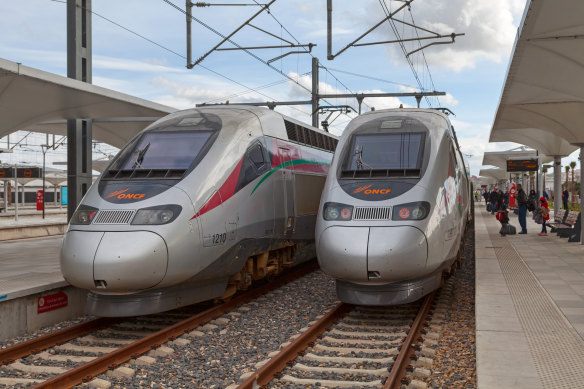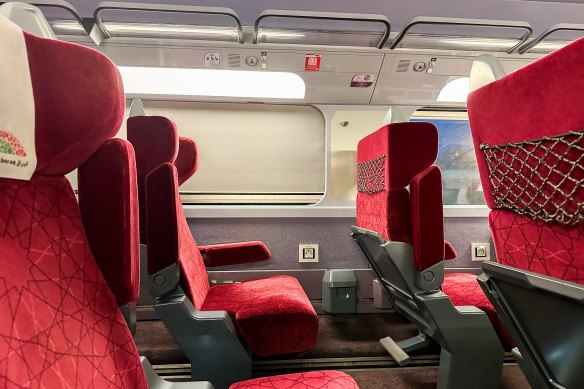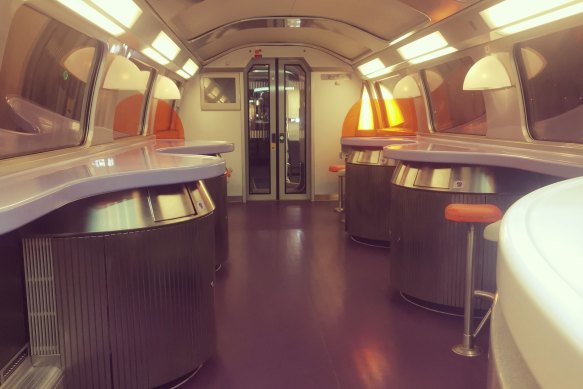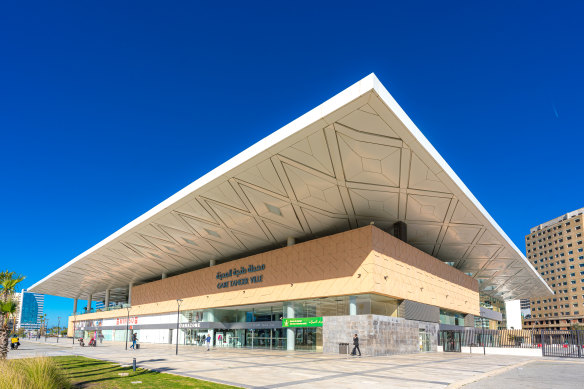Africa’s first high-speed train puts Australia to shame
By John Borthwick
The train: Al Boraq, Morocco
- The route Casablanca to Tangier
- Distance/time 323 kilometres / 2 hours, 10 minutes
- Operator ONCF
- Class First, with reservations
- Frequency 14 services daily

Morocco’s high-speed Al Boraq operated by ONCF.Credit: Getty Images
The journey
Morocco’s most famous train, the musically celebrated Marrakesh Express has been overtaken by the high-speed Al Boraq. Its 323-kilometre sprint from Casablanca’s Casa Voyageurs station to the Tanger Ville terminus at Tangier takes two hours and 10 minutes. The first TGV (Train à Grande Vitesse) service in Africa, this is a joint venture between the Moroccan national rail operator ONCF and its French equivalent, SNCF. My train departs exactly on time at 8am, stopping only for seven minutes each at Rabat and Kenitra, arriving one minute early at Tangier.
The class
First class. The Al Boraq has two first-class cars and five second-class carriages, all are double-deck. The first class seating configuration is 2-1, with some seats facing rearwards. There is ample aisle width and legroom. The few announcements made are in Arabic and French, but not English. Clean, compact washrooms.
Boarding
The Al Boraq Lounge on the concourse level of Casablanca’s Casa Voyageurs station is for first class passengers, and offers free Wi-Fi, bathrooms, seating, tea, coffee and bottled water. We relax here until 15 minutes before being summoned (Mesdames et messieurs ...) to board. With our QR-coded tickets scanned, we descend one level to the restricted platform where the eight-car train awaits.
The seat

The well-padded, red-upholstered seats recline marginally.Credit: Shutterstock
My reserved window seat, 116 in Car Two upper level, is in a quadruple cluster where two forward-facing and two rearward-facing seats oppose each other, well-distanced, across a wall-mounted table in the middle. The well-padded, red-upholstered seats recline marginally. Each has an armrest, footrest, waste-bin, shade blind and Type-C, two-prong power-point. There are no USB ports nor onboard Wi-Fi, however the phone connection works, allowing hotspot internet usage. Seating is allocated, but local commuters with a rail pass may occupy a vacant seat until it is required by a passenger with reservation.
Baggage
The two luggage racks are located at the front and middle of the car, with overhead storage for smaller items. The limited capacity is adequate because most passengers are local intercity travellers and Rabat commuters with light carry-on luggage, rather than large suitcases.
Food + drink

The spacious canteen carriage where dining counters face towards large, panoramic windows.Credit: Shutterstock
A spacious buffet car in the middle of the train has staff service and vending machines. Dining counters face towards large, panoramic windows and an ever-changing landscape. There’s an English language menu for hot snacks, sandwiches and beverages, but no alcohol. Coffee costs the equivalent of $3.50 and croissants $1.50.
Carbon emissions
When travelling this route on the diesel-electric Al Boraq, a passenger’s carbon emission footprint is just one kilogram, compared with 128 kilograms by plane.

The station in Tangier – Gare Tanger Ville.Credit: Getty
One more thing
“I suppose you’ve had high-speed trains like this for years in Australia?” It’s the question I’m hoping that doesn’t come from the Moroccan businesswoman beside me with whom I’ve been chatting. She spares me the angst. Like most rail projects, the Al Boraq line which launched in 2018, ran well over-time and over-budget. Tickets may be booked through Sydney-based Morocco specialists, By Prior Arrangement Travel. See bypriorarrangement.com
The verdict
An excellent service with international-standard facilities and operation. Daylight travel is recommended to best see the varied Moroccan coastal and agricultural landscape.
The price
First class seats from €49 ($A80.77)
Our rating out of five
★★★★½
The writer travelled courtesy of By Prior Arrangement Travel.
Sign up for the Traveller newsletter
The latest travel news, tips and inspiration delivered to your inbox. Sign up now.